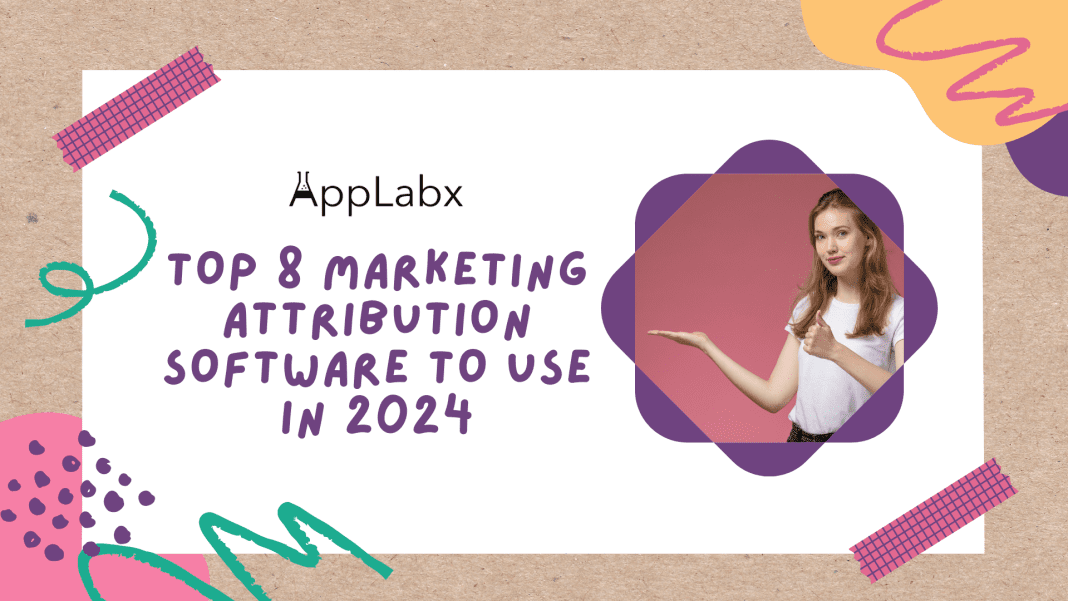Key Takeaways
- Streamline Marketing Efforts: Elevate your strategies in 2024 by adopting a unified platform for streamlined analytics, ensuring optimal ROI and strategic decision-making.
- Unleash Versatility in Data Blending: Explore the dynamic landscape of attribution tools, seamlessly blending cross-platform data for unparalleled insights into the diverse channels shaping your marketing success.
- Embrace Predictive Analytics: Unlock the power of predictive analytics, stepping into the future of marketing insights in 2024. Our comprehensive guide is your key to staying ahead in the dynamic digital landscape.
In the dynamic realm of digital marketing, understanding the efficacy of each touchpoint in a customer’s journey is paramount.
As businesses navigate the evolving landscape of consumer behavior and engagement, the need for robust marketing attribution has never been more critical.
In 2024, marketers are faced with a multitude of channels and platforms, making it increasingly challenging to attribute success accurately.
Enter the era of Marketing Attribution Software – a game-changer in deciphering the intricate paths customers take before making a purchase or engaging with a brand.
This blog aims to delve deep into the intricacies of this transformative technology, shedding light on the “Top 8 Marketing Attribution Software to Use in 2024.”
Whether you’re a seasoned marketer seeking to enhance your attribution strategies or a business owner eager to maximize ROI, this comprehensive guide will empower you to make informed decisions.
The Evolving Marketing Landscape
The marketing landscape is in a perpetual state of evolution, driven by technological advancements and shifting consumer behaviors.
In 2024, the digital terrain has become more expansive, encompassing social media, search engines, email campaigns, and an array of other touchpoints.
Understanding the contribution of each channel to the overall customer journey is akin to deciphering a complex puzzle, and this is precisely where marketing attribution software steps in.
Increased Complexity of Customer Journeys
Gone are the days of linear customer journeys. In 2024, consumers traverse a web of touchpoints, seamlessly switching between online and offline interactions.
From social media exposure to email marketing, from online searches to in-store visits, the customer journey has become a labyrinth of interactions.
Marketing attribution software acts as a guiding light, offering insights into the various touchpoints that influence a customer’s decision-making process.
Introducing the Top 8 Marketing Attribution Software for 2024
Now that we’ve explored the significance of marketing attribution and the key features to look for in a robust solution, it’s time to unveil the stars of 2024 – the top 8 marketing attribution software that is poised to redefine the way businesses analyze and optimize their marketing efforts.
In this exhaustive exploration of marketing attribution software, we aim to equip you with the knowledge needed to navigate the intricate world of customer attribution.
Join us as we unravel the features, benefits, and user experiences of the leading solutions that are set to make waves in 2024.
Whether you’re a marketing professional, business owner, or simply curious about the future of marketing technology, this blog serves as your compass in the dynamic realm of marketing attribution.
But, before we venture further, we like to share who we are and what we do.
About AppLabx
From developing a solid marketing plan to creating compelling content, optimizing for search engines, leveraging social media, and utilizing paid advertising, AppLabx offers a comprehensive suite of digital marketing services designed to drive growth and profitability for your business.
AppLabx is well known for helping companies and startups use digital marketing to drive web traffic to their websites and web apps.
At AppLabx, we understand that no two businesses are alike. That’s why we take a personalized approach to every project, working closely with our clients to understand their unique needs and goals, and developing customized strategies to help them achieve success.
If you need a digital consultation, then send in an inquiry here.
Top 8 Marketing Attribution Software To Use In 2024
1. HubSpot
In the ever-evolving landscape of marketing, Hubspot’s marketing attribution software stands as a truly revolutionary force, reshaping how businesses, regardless of size, approach their marketing endeavors.
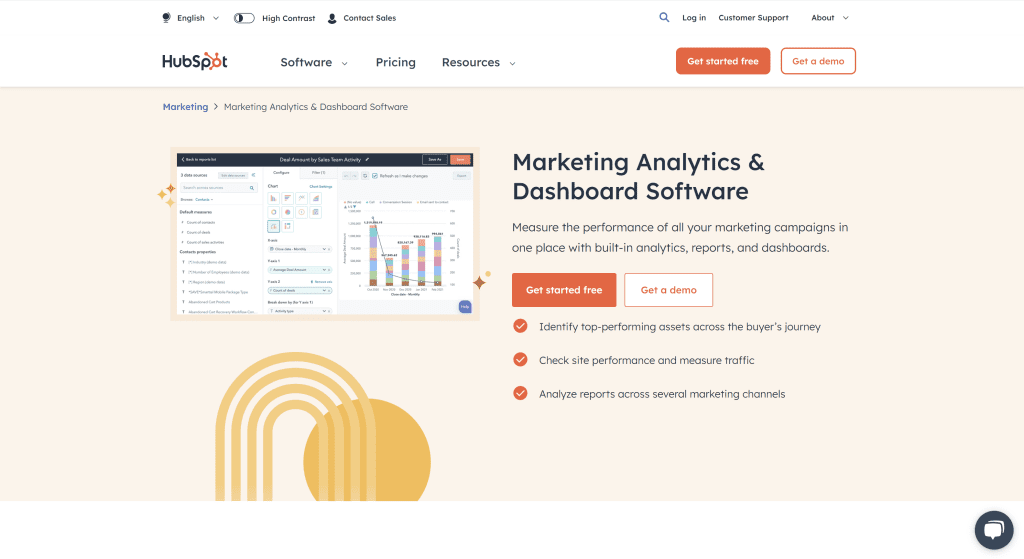
Streamlined Processes and Features
Hubspot’s platform goes beyond the ordinary, streamlining the intricate processes of tracking, analyzing, and optimizing marketing campaigns.
Its arsenal includes multi-touch attribution, customized reporting tools, and seamless integration capabilities. These features collectively empower businesses to navigate the complex web of customer interactions with unparalleled precision.
Why Hubspot Stands Out
As a discerning marketing connoisseur, the choice of Hubspot as the premier all-in-one marketing attribution platform was inevitable.
What sets Hubspot apart is its harmonious fusion of Customer Relationship Management (CRM), marketing automation, and analytics, all seamlessly presented through a user-friendly interface.
This amalgamation creates an ecosystem where data-driven decision-making becomes not just a possibility but a streamlined reality.
Hubspot’s Features and Integrations Unveiled
Features
Hubspot boasts a robust suite, encompassing a marketing lead database, lead capture mechanisms, segmentation tools, omnichannel marketing automation, and efficient pipeline management.
Each facet contributes to a comprehensive marketing solution, catering to the diverse needs of businesses navigating the intricate realm of customer engagement.
Integrations
Hubspot’s prowess extends beyond its native features through seamless integrations with an array of platforms. The platform synchronizes effortlessly with Eventbrite, Drift, Slack, LinkedIn, Google Sheets, Wistia, Zapier, Mailchimp, Salesforce, and Shopify.
This expansive integration network ensures a cohesive marketing ecosystem where data flows seamlessly, unlocking endless possibilities for strategic marketing endeavors.
Pros and Cons: Navigating Hubspot’s Landscape
Pros
- Efficient Data Consolidation: Hubspot excels in consolidating data and insights, streamlining marketing efforts with a singular focus.
- Advanced Attribution Models: The platform doesn’t just offer attribution; it provides advanced models that delve deep into customer journeys, offering unparalleled insights.
- Scalability: Hubspot’s scalability is a notable strength, accommodating businesses of all sizes and varying needs.
Cons
- Pricing Considerations: While Hubspot’s features are robust, the pricing structure may pose challenges for small businesses, potentially limiting access to certain advanced features.
- Learning Curve: Despite its user-friendly interface, the platform’s extensive features may present a learning curve for some users, necessitating dedicated training and exploration.
In essence, Hubspot’s marketing attribution software is a testament to the evolution of marketing technology. It is a tool that not only simplifies but elevates the way businesses understand and engage with their audience.
As we delve into the landscape of marketing attribution software for 2024, Hubspot undeniably stands as a beacon of innovation, setting the standard for comprehensive and effective marketing solutions.
2. Windsor.ai
In the realm of marketing attribution, Windsor.ai emerges as a versatile software, strategically designed to assist businesses in meticulous tracking of marketing endeavors across a diverse spectrum of channels and campaigns.
Its prowess lies not only in tracking but also in excelling at the identification of effective strategies that drive sales and conversions to new heights.
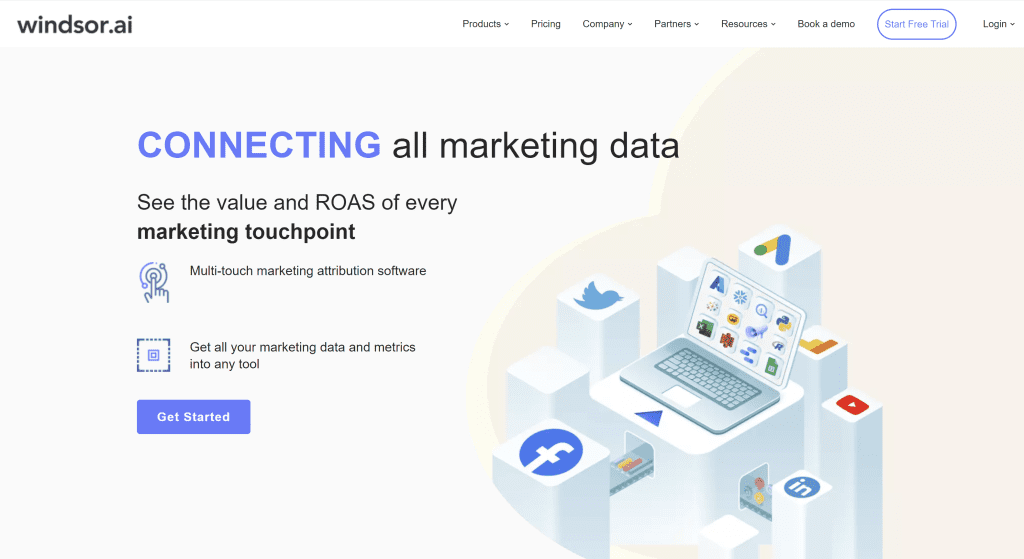
A Prime Choice for Data-Driven Decisions
Windsor.ai positions itself as a prime choice for businesses eager to fortify their decision-making processes with a data-centric approach.
The software’s adaptability and user-friendly setup make it a beacon for those seeking to optimize their marketing initiatives through insightful analytics and comprehensive reporting.
Why Windsor.ai Stands Out
The allure of Windsor.ai is not just in its functionality but in its adaptability, versatility, and innovative API-first approach.
This unique feature set renders it particularly suitable for startups and businesses with the imperative need to seamlessly integrate data from multiple sources, creating a cohesive and comprehensive analytical environment.
Windsor.ai’s Features and Integration Landscape Unveiled
Features
Windsor.ai distinguishes itself through a robust suite of features, including cross-platform data blending, multi-touch attribution models, extended reporting date ranges, search terms optimization, bid and budget optimization tools, and API/database access.
Each feature is meticulously crafted to provide businesses with a multifaceted toolkit for nuanced marketing analysis.
Integrations
Windsor.ai’s integration capabilities extend across major marketing platforms, solidifying its position as a versatile player in the market.
The software seamlessly integrates with platforms such as Google Analytics, Google Ads, Salesforce, Facebook, X (formerly Twitter), Instagram, TikTok, and Snapchat, ensuring a synchronized flow of data from various sources.
Pros and Cons: Navigating Windsor.ai’s Landscape
Pros
- Effortless Attribution: Windsor.ai simplifies both single and multi-channel attribution, offering businesses a comprehensive view of their marketing impact.
- Exceptional Customer Service: The software stands out with its commitment to customer service and support, providing users with a reliable resource for troubleshooting and guidance.
- Enhanced Visibility: Windsor.ai elevates visibility into expenditures on digital media, allowing businesses to make informed decisions regarding their marketing budgets.
Cons
- Performance Challenges: In the face of substantial data volumes, particularly on mobile and tablet devices, Windsor.ai may encounter performance issues that could potentially impact user experience.
- Limitations in the Free Plan: While Windsor.ai offers a free plan, its functionality is limited, potentially prompting businesses with advanced needs to explore premium options for a more comprehensive feature set.
In essence, Windsor.ai emerges as a dynamic force in the realm of marketing attribution, offering businesses a nuanced and adaptable solution to navigate the complexities of the digital marketing landscape.
As we explore the top contenders in marketing attribution software for 2024, Windsor.ai unquestionably stands out as a key player, providing businesses with the tools they need for insightful analysis and strategic decision-making.
3. Branch
In the dynamic landscape of e-commerce growth, the choice of the right marketing attribution solution is akin to fueling the engine that propels your business forward.
What sets a solution apart is not merely its functionality but its commitment to client-centric values.
Branch, in particular, stands out by eschewing the conventional approach of charging for each conversion or commodifying retargeting data. Instead, its singular focus is on cultivating user loyalty and satisfaction.
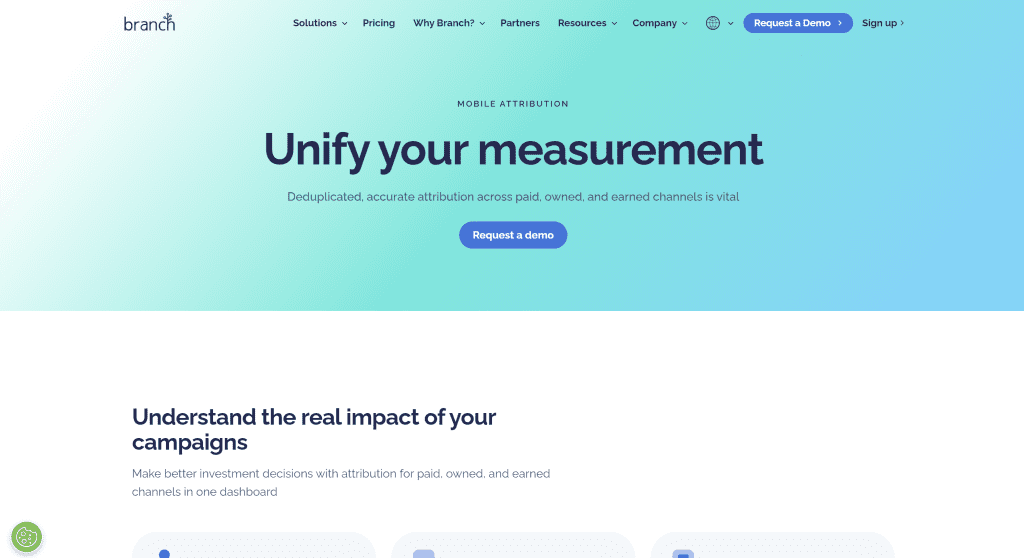
Data Freedom and the Choice of Branch
The decision to opt for Branch in the expansive realm of marketing attribution solutions stems from its commitment to data freedom.
This encompasses a spectrum of offerings including integrations, APIs, webhooks, and CSV exports.
Centralized data across all ad networks ensures deduplicated and precise conversion data, creating a foundation for strategic decision-making.
Branch: Unveiling Standout Features and Integrations
Features
Branch positions itself as a beacon of reliability in the realm of mobile campaigns.
It goes beyond delivering data; it provides a reliable and unbiased foundation for decision-making.
By removing the guesswork, Branch brings clarity even to the most intricate conversion paths, facilitating strategic and data-driven marketing initiatives.
Integrations
The integration landscape of Branch is expansive and diverse, catering to the varied needs of businesses. From NET SDK, Next.js, and Eleventy to Google BigQuery, Mailjet, Shopify, Zendesk, and Android SDK, Branch seamlessly weaves itself into the fabric of numerous platforms.
This extensive integration network serves as a testament to its commitment to providing businesses with a consolidated and user-friendly ecosystem.
Pros and Cons: Navigating the Branch Landscape
Pros
- Frequent Updates: Branch distinguishes itself by actively addressing and resolving issues through regular updates, ensuring a continually optimized user experience.
- Cost-Effective User Acquisition Analysis: The platform offers a cost-effective and lightweight approach to user acquisition analysis, enabling businesses to enhance their strategies without burdening their budgets.
- Versatile Integration Options: Branch’s compatibility spans a wide range of platforms, enhancing data consolidation and ease of use for businesses seeking seamless integration into their existing ecosystems.
Cons
- Occasional Post-Publishing Restrictions: Users may encounter occasional restrictions on post-publishing without clear explanations, potentially disrupting the workflow without apparent reasons.
- Lack of Free Trial: While Branch boasts a range of features, the absence of a free trial option may pose a hurdle for potential users who seek to explore its capabilities before committing to a subscription.
In the expansive landscape of marketing attribution solutions, Branch emerges not just as a tool but as a strategic partner in fostering e-commerce growth.
Its commitment to data freedom, reliability, and client-centric values positions it as a formidable player in the realm of advanced marketing analytics.
As businesses navigate the intricacies of digital growth, Branch stands ready to provide the tools needed to navigate the complexities and drive success.
4. Google Analytics 360
In the realm of data analysis and decision-making, Google Analytics 360 stands as an integral component of the world’s most widely used analytics platform.
For businesses seeking a streamlined approach to data analysis, this offering becomes a logical choice, forming a critical part of their strategy to simplify complex datasets and derive meaningful insights.

Native Connectivity and Cross-Channel Data Fusion
At the heart of Google Analytics 360’s appeal is its seamless native connectivity to the Google performance and advertising data ecosystem.
This feature becomes instrumental in the rapid combination of cross-channel data, spanning diverse sources such as IoT, digital point-of-sale systems, and CRM software.
The result is a cohesive data landscape that enables businesses to glean actionable insights from a multitude of channels.
Why Google Analytics 360 Stands Out
The rationale behind choosing Google Analytics 360 is rooted in its association with the Google Analytics 360 Suite.
This integration positions the platform as an all-encompassing solution, providing businesses with an integrated set of marketing optimization tools.
For enterprises striving to streamline their analytics processes, Google Analytics 360 emerges as a comprehensive and unified solution.
Google Analytics 360: Unveiling Features and Integration Prowess
Features
Attribution 360 distinguishes itself with unique features, including Marketing Mix Modeling tailored for both offline and digital channels.
This capability enables businesses to gain insights into external factors influencing their performance, even extending its purview to evaluate the impact of television ads.
The platform goes beyond conventional attribution models, offering a more holistic perspective on marketing effectiveness.
Integrations
Google Analytics 360 seamlessly integrates with a spectrum of platforms, including native Google products such as Salesforce, Campaign Monitor, Sprout Social, Wix, Semrush, and Mailchimp.
This expansive integration network ensures that businesses can effortlessly consolidate their data ecosystem, providing a unified view of their marketing landscape.
Pros and Cons: Navigating the Google Analytics 360 Landscape
Pros
- Easy Installation and Understanding: The platform excels in user-friendliness, offering easy installation and a straightforward interface that simplifies the user experience.
- Detailed User Behavior Insights: Google Analytics 360 provides granular insights into website user behaviors, empowering businesses with a profound understanding of their audience.
- Direct Integration with Google Products: The direct integration with other Google products ensures a seamless experience for businesses already leveraging the Google ecosystem.
Cons
- Aggressively Priced Paid Features: Some businesses may find the pricing of paid features to be on the aggressive side, potentially posing budgetary considerations.
- Limited Customization Options: In comparison to certain competitors, Google Analytics 360 may have limited customization options, restricting flexibility for businesses with unique analytical requirements.
In conclusion, Google Analytics 360 emerges not just as a tool but as a strategic ally in the realm of data-driven decision-making.
As businesses navigate the complexities of their analytics landscape, this platform, with its integration capabilities, unique features, and association with the Google Analytics 360 Suite, stands ready to elevate their analytics game and simplify the path to informed decision-making.
5. Adobe Analytics
In the domain of advanced web analytics and nuanced customer behavior insights, Adobe Analytics emerges as the quintessential tool, offering a diverse array of attribution models, including the prowess of algorithmic attribution fueled by advanced machine learning.
This robust platform stands as the epitome of sophistication, empowering businesses to delve into the intricacies of user interactions and glean insights that go beyond the surface.
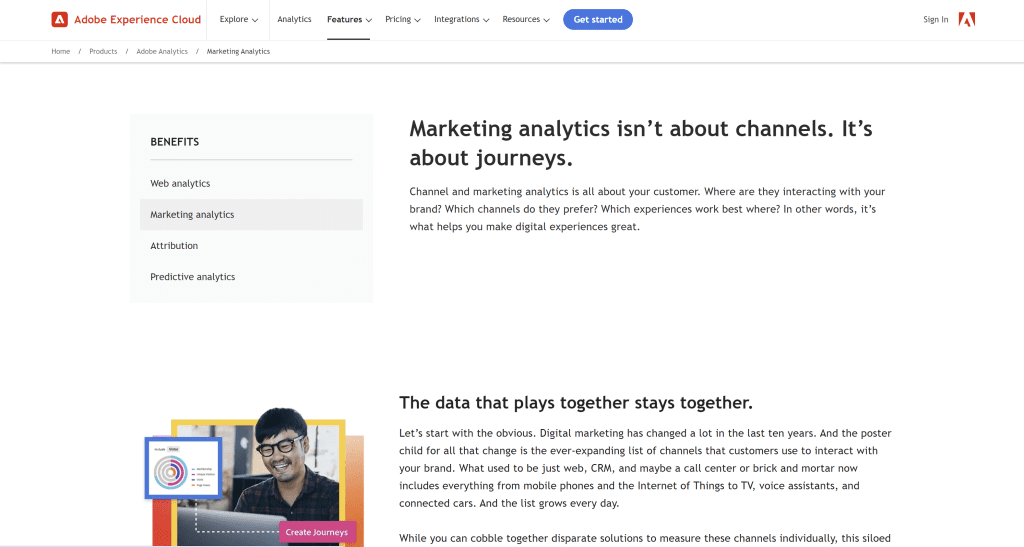
The Selection of Adobe Analytics: A Dive into Deep Data Analysis
The decision to choose Adobe Analytics as the preferred tool is rooted in its remarkable capabilities in deep data analysis. The platform transcends conventional analytics, unraveling hidden patterns and spotlighting statistical anomalies.
Its unique ability to uncover correlations behind unexpected customer behavior, identify unusual data points, and discern sudden shifts in metrics across different audience segments sets it apart as a tool designed for the discerning analyst.
Adobe Analytics: Features and Integration Mastery
Features
Adobe’s data warehouse serves as the bedrock of sophisticated data storage, equipped with reprocessing capabilities and an arsenal of extensive reporting tools.
Beyond this, its data feeds stand out by providing regular batch delivery of raw, insightful data, adding an extra layer of flexibility to the analytical process.
Integrations
Adobe Analytics seamlessly integrates with a suite of renowned platforms, creating a comprehensive ecosystem.
From Adobe’s own suite to collaborations with Hootsuite, Invoca, Branch.io, and BrightEdge, the platform ensures that businesses can integrate their analytics seamlessly into their existing tech stack.
Pros and Cons: Navigating Adobe Analytics’ Landscape
Pros
- Empowered Decision-Making: Adobe Analytics goes beyond traditional analytics, empowering decision-makers with predictive analytics capabilities that anticipate trends and potential shifts.
- Detailed Channel and Marketing Analytics: The platform provides in-depth channel and marketing analytics, offering businesses a profound understanding of user interactions across various touchpoints.
- Persistent IDs for Reliable Attribution: The use of persistent IDs ensures consistent and reliable data attribution over time, enhancing the accuracy of insights derived from the platform.
Cons
- Steep Initial Learning Curve: For users not well-versed in technical intricacies, the initial learning curve of Adobe Analytics may prove to be challenging.
- Lack of Free Trial: The absence of a free trial option may discourage prospective users from exploring the platform’s capabilities firsthand, potentially hindering adoption.
In essence, Adobe Analytics stands as a beacon of excellence in the realm of advanced web analytics.
Its commitment to deep data analysis, predictive analytics, and seamless integration sets it apart as a tool tailored for businesses seeking not just data, but actionable insights that drive strategic decision-making.
As we explore the top-tier players in web analytics for 2024, Adobe Analytics undeniably holds its ground as a frontrunner in the pursuit of analytical excellence.
6. LeadsRx
In the realm of marketing attribution solutions, LeadsRX emerges as a beacon of insight, offering a panoramic view of the customer journey.
At its core lies the Universal Conversion Tracking Pixel™, a revolutionary tool that empowers marketers to optimize campaigns and budgets in real-time, thereby elevating Return on Advertising Spend (ROAS) to new heights.
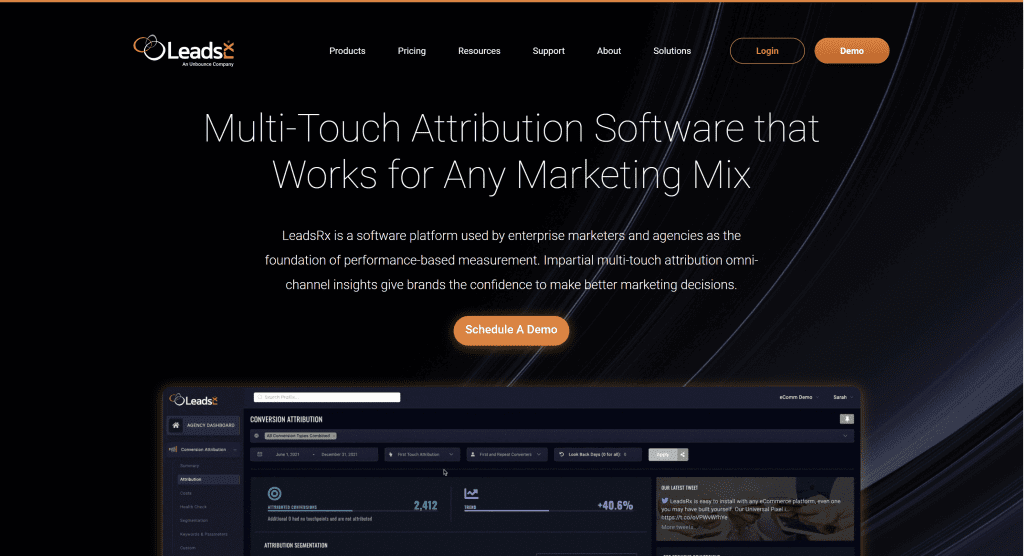
The Choice of LeadsRX: Elevating Beyond Traditional Analytics
The decision to select LeadsRX is driven by its capacity to transcend the confines of traditional digital analytics.
The Universal Conversion Tracking Pixel™ serves as a linchpin, providing not only complete online coverage but also extending its reach to offline channels—a rarity in the competitive landscape.
This distinctive feature positions LeadsRX as a potential game-changer for businesses implementing diverse advertising strategies.
LeadsRX: Unveiling Standout Features and Integration Dynamics
Features
LeadsRX’s standout feature lies in its cross-domain, cross-device tracking capabilities. This remarkable functionality grants marketers a comprehensive view of customer journeys, encompassing offline channels—an exceptional offering in the marketing attribution domain.
This panoramic perspective enhances the granularity of insights, allowing businesses to decipher complex customer interactions.
Integrations
While a detailed list of integrations is best obtained by reaching out to LeadsRX directly, notable partnerships include Salesforce, Optimizely, HubSpot, and CallRail.
These integrations further enrich the platform’s capabilities, providing businesses with a seamless and interconnected ecosystem.
Pros and Cons: Navigating the Landscape of LeadsRX
Pros
- Holistic View with Universal Conversion Tracking Pixel™: LeadsRX’s Universal Conversion Tracking Pixel™ stands out by delivering a comprehensive and holistic view of customer journeys, combining online and offline channels.
- Real-Time Insights for Nimble Adjustments: The platform empowers marketers with real-time insights, enabling swift adjustments to campaigns and budgets for optimal performance.
- Data-Driven Evaluation of Marketing Strategies: LeadsRX’s data insights provide a fair and data-driven evaluation of the effectiveness of various marketing strategies, allowing for informed decision-making.
Cons
- Absence of Visible Pricing Details: The absence of visible pricing details on the website may pose an inconvenience for businesses seeking transparency in cost considerations.
- Lack of a Free Trial: The absence of a free trial option might deter potential users who prefer to sample the platform’s capabilities before committing to a purchase.
In essence, LeadsRX emerges not just as a marketing attribution solution but as a catalyst for strategic marketing excellence.
With its unique capabilities in cross-domain tracking and offline channel coverage, LeadsRX is poised to redefine the standards of comprehensive insights in the ever-evolving landscape of marketing analytics.
As businesses navigate the complexities of customer journeys, LeadsRX stands ready to illuminate the path with its innovative and holistic approach to marketing attribution.
7. Ruler Analytics
In the realm of marketing attribution, Ruler Analytics emerges as a potent tool, dedicated to delivering insightful data and precise multi-touch attribution.
This powerful platform empowers businesses to make informed decisions, offering a pivotal upgrade to their marketing endeavors.

The Selection of Ruler Analytics: Unraveling Caller Journeys for Small Businesses
The choice to embrace Ruler Analytics as a top-tier marketing attribution software for small businesses immersed in online marketing is underpinned by its impressive capabilities.
The platform goes beyond the ordinary, showcasing a unique prowess in tracking static and offline calls.
This distinctive feature unravels invaluable insights into caller journeys, marking Ruler Analytics as a standout solution in the competitive landscape.
Ruler Analytics: Features Redefining Marketing Dynamics
Features
Ruler Analytics distinguishes itself through its comprehensive suite of features, excelling in lead and channel management.
The platform places a strong emphasis on Return on Investment (ROI), coupled with visitor tracking and data-driven marketing decisions. Its holistic approach addresses the nuanced needs of small businesses, providing a robust toolkit for strategic marketing initiatives.
Integrations
Seamless integration is a cornerstone of Ruler Analytics, aligning with platforms such as HubSpot, Mailchimp, Zoho CRM, Google Ads, and Marketo.
This integration network ensures a comprehensive view of marketing efforts, fostering a connected ecosystem that enhances the efficiency of small business marketing strategies.
Pros and Cons: Navigating Ruler Analytics’ Landscape
Pros
- Tracking Form Submissions and Online Chat Interactions: Ruler Analytics stands out by offering the ability to track not only form submissions but also online chat interactions, providing a holistic view of user engagement.
- Matching Multiple Clicks to Form Submissions and Phone Calls: The platform enhances precision by enabling the matching of multiple clicks to both form submissions and phone calls, offering a granular understanding of user interactions.
- Unique Tracking of Static and Offline Calls: Ruler Analytics possesses a unique ability to track and analyze both static and offline calls, delivering valuable insights into the complete customer journey.
Cons
- Feature Overwhelm Potential: The abundance of features in Ruler Analytics might be intimidating for some users, potentially requiring a learning curve to fully leverage its capabilities.
- Challenges in Tracking Performance Improvement Over Time: Tracking performance improvement over a specific period can be challenging, potentially hindering users in assessing the evolving impact of their marketing efforts.
In essence, Ruler Analytics emerges as more than just a tool; it becomes a strategic ally for small businesses navigating the intricacies of online marketing.
With its unique tracking capabilities, comprehensive feature set, and seamless integrations, Ruler Analytics proves to be a catalyst for precision and efficacy in the realm of marketing attribution.
As businesses seek to upgrade their marketing endeavors, Ruler Analytics stands ready to redefine the landscape with its innovative approach and insightful data analytics.
8. Attribution
In the realm of enterprise multi-touch attribution, Attribution emerges as a formidable software solution, dedicated to identifying the specific impact of each touchpoint within your marketing funnel.
This sophisticated tool caters to the diverse needs of both B2C and B2B marketers, offering a comprehensive suite of features designed to optimize marketing Return on Investment (ROI) and streamline the path to purchase.

Automating Data Collection for Holistic Insights
At the heart of Attribution lies its automated data collection feature, a robust mechanism that systematically organizes all online and offline touchpoints.
This data is seamlessly combined with budget spending information, providing businesses with a panoramic view of their marketing landscape.
This holistic approach ensures that no touchpoint goes unnoticed, enabling businesses to derive actionable insights from the entirety of their marketing efforts.
Pro Tips for Enhanced Performance Management
A pro tip for maximizing the utility of Attribution is its utility in managing affiliate marketing.
Businesses can leverage the tool to report on and improve partner performance, facilitating a data-driven approach to affiliate management.
Furthermore, Attribution allows for a comparative analysis of affiliate performance against other marketing touchpoints and channels, enabling businesses to optimize their affiliate strategies in alignment with broader marketing objectives.
Automated Attribution Modeling with Machine Learning
Attribution takes automation a step further with its capability to build automated attribution models using advanced machine learning algorithms.
These algorithms surface patterns within the data and touchpoints, providing businesses with valuable insights into the effectiveness of their marketing strategies.
By leveraging machine learning, Attribution empowers businesses to make informed decisions based on data-driven analysis, driving performance improvement across their marketing endeavors.
Segmented Data Analysis and Seamless Integration
The platform’s dashboards and reports offer robust capabilities for segmenting data by campaign, touchpoint, or channel, providing businesses with granular insights into their marketing performance.
Additionally, Attribution seamlessly syncs all data with other software tools such as Customer Relationship Management (CRM) systems, marketing tools, or business intelligence platforms.
This integration ensures that businesses can leverage their data across multiple touchpoints, facilitating a cohesive and data-driven approach to marketing decision-making.
In essence, Attribution stands as more than just a tool; it becomes a strategic ally for businesses seeking to unravel the complexities of their marketing impact.
With its comprehensive feature set, automated attribution modeling, and seamless integration capabilities, Attribution empowers businesses to optimize their marketing strategies, drive performance improvement, and achieve their business objectives with precision and efficacy.
Conclusion
In the dynamic landscape of digital marketing, the choices we make in our technology stack can significantly impact the trajectory of our business success.
As we delve into the realm of marketing attribution, the year 2024 presents a captivating array of cutting-edge solutions designed to unravel the complexities of customer journeys, optimize campaigns, and elevate the overall efficiency of marketing endeavors.
Among the top contenders for supremacy in this arena, the eight marketing attribution software – HubSpot, Windsor.ai, Branch, Google Analytics 360, Adobe Analytics, LeadsRx, Ruler Analytics, and Attribution – collectively stand as pillars of innovation, each bringing its unique strengths to the table.
HubSpot: The All-In-One Marketing Dynamo
HubSpot, a name synonymous with marketing excellence, revolutionizes the landscape with its comprehensive suite of features.
From CRM and marketing automation to analytics, HubSpot seamlessly integrates these elements, offering businesses a unified platform for streamlined marketing efforts. The advanced attribution models and scalability make HubSpot an ideal choice for businesses of all sizes.
Windsor.ai: Versatility Unleashed
Windsor.ai emerges as a dynamic force, emphasizing adaptability and versatility.
With cross-platform data blending, multi-touch attribution, and a wide array of integrations, Windsor.ai provides businesses with the tools to navigate the intricacies of the modern marketing landscape.
Its API-first approach and compatibility with various platforms position it as a versatile ally for businesses with diverse marketing strategies.
Branch: Catalyst for Advanced Attribution
Branch stands out as a catalyst for advanced attribution, seamlessly integrating with major platforms and providing a holistic view of user interactions.
With its Universal Conversion Tracking Pixel™ and real-time insights, Branch empowers businesses to optimize their campaigns on the go. Its compatibility with various frameworks and platforms makes it a robust choice for those seeking precision in their marketing analytics.
Google Analytics 360: Precision in Performance
As part of the Google Analytics 360 Suite, Google Analytics 360 asserts its dominance with a precision-focused approach.
The platform’s unique features, including Marketing Mix Modeling and native connectivity, offer businesses an unparalleled understanding of their marketing impact.
The integration with Google products ensures a seamless experience, making it a powerhouse for data-driven decision-making.
Adobe Analytics: Deep Dive into Data
Adobe Analytics takes the stage as a powerhouse for deep data analysis and predictive analytics. With its Universal Conversion Tracking Pixel™, it not only tracks online interactions but also extends its reach to offline channels.
The machine learning algorithms and extensive reporting tools make Adobe Analytics a go-to choice for businesses seeking granular insights and predictive analytics.
LeadsRx: Illuminating the Customer Journey
LeadsRx positions itself as an insightful marketing attribution solution, unraveling the intricacies of the customer journey. With the ability to track static and offline calls, LeadsRx delivers invaluable insights.
Its cross-domain, cross-device tracking and integration capabilities make it a robust choice for businesses striving for a comprehensive understanding of user interactions.
Ruler Analytics: Precision for Small Businesses
Ruler Analytics emerges as a precision tool tailored for small businesses, offering unique capabilities in tracking static and offline calls.
With its automated data collection and seamless integration with various platforms, Ruler Analytics stands as a game-changer for small businesses seeking holistic insights into their marketing impact.
Attribution: The Future of Marketing Insight
Finally, we have Attribution, a software dedicated to unraveling marketing impact with precision. Its enterprise multi-touch attribution capabilities, coupled with automated data collection and machine learning algorithms, make it a force to be reckoned with.
With features ideal for both B2C and B2B marketers, Attribution is a strategic choice for businesses seeking to optimize their marketing ROI.
If you are looking for a top-class digital marketer, then book a free consultation slot here.
If you find this article useful, why not share it with your friends and business partners, and also leave a nice comment below?
We, at the AppLabx Research Team, strive to bring the latest and most meaningful data, guides, and statistics to your doorstep.
To get access to top-quality guides, click over to the AppLabx Blog.
People also ask
What is the best marketing attribution model?
The best marketing attribution model depends on your business goals and the complexity of your customer journey. Linear, Time Decay, and U-Shaped models are commonly used, but a data-driven model, considering various touchpoints, often offers a more nuanced understanding of user interactions for effective decision-making.
What is attribution software?
Attribution software is a tool that helps businesses analyze and attribute value to different touchpoints in a customer’s journey. It tracks and evaluates marketing channels, allowing businesses to understand which interactions contribute most to conversions, aiding in optimizing marketing strategies.
What does attribution mean in marketing?
In marketing, attribution refers to the process of identifying and assigning value to various touchpoints a customer interacts with before making a purchase. It helps businesses understand the effectiveness of each marketing channel in influencing consumer decisions and optimizing marketing strategies.


























